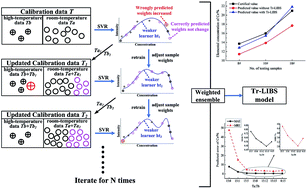当前位置:
X-MOL 学术
›
J. Anal. At. Spectrom.
›
论文详情
Our official English website, www.x-mol.net, welcomes your
feedback! (Note: you will need to create a separate account there.)
An LIBS quantitative analysis method for alloy steel at high temperature based on transfer learning
Journal of Analytical Atomic Spectrometry ( IF 3.1 ) Pub Date : 2018-05-24 00:00:00 , DOI: 10.1039/c8ja00069g Jianhong Yang 1, 2, 3, 4 , Xiaomeng Li 1, 2, 3, 4 , Huili Lu 2, 3, 4, 5 , Jinwu Xu 1, 2, 3, 4 , Haixia Li 3, 4, 6, 7
Journal of Analytical Atomic Spectrometry ( IF 3.1 ) Pub Date : 2018-05-24 00:00:00 , DOI: 10.1039/c8ja00069g Jianhong Yang 1, 2, 3, 4 , Xiaomeng Li 1, 2, 3, 4 , Huili Lu 2, 3, 4, 5 , Jinwu Xu 1, 2, 3, 4 , Haixia Li 3, 4, 6, 7
Affiliation

|
The analysis accuracy of laser-induced breakdown spectroscopy (LIBS) in high temperature applications will decrease when certified standard samples used for building calibration curves are insufficient. A novel LIBS quantitative method based on transfer learning is proposed, in which information on the spectra at room temperature is transferred to the spectra at high temperature in order to assist in building a better regression model. An iterative weight adjusting scheme is used for different samples in model training and the concept of ensemble learning is involved when the results of testing samples are predicted. Experiments on certified alloy steel standard samples were conducted to analyze Cr concentrations. The calibration dataset consisted of 15 standard samples at room temperature and 4 standard samples at high temperature. Another 3 samples at high temperature were used for testing. The results showed that the average absolute and relative errors of 3 testing samples were reduced by 1.8% and 20.58%, respectively. The proposed method provides a feasible way for LIBS analysis of samples at high temperature with lower cost and enhances the potentiality of LIBS in online industrial measurement in high temperature production processes, such as iron and steel smelting.
中文翻译:

基于转移学习的高温合金钢LIBS定量分析方法
当用于建筑校准曲线的认证标准样品不足时,高温应用中的激光诱导击穿光谱法(LIBS)的分析准确性将降低。提出了一种基于转移学习的LIBS定量方法,该方法将室温下的光谱信息转移到高温下的光谱,以帮助建立更好的回归模型。迭代权重调整方案用于模型训练中的不同样本,并且在预测测试样本的结果时会涉及整体学习的概念。对认证的合金钢标准样品进行了实验,以分析Cr的浓度。校准数据集由室温下的15个标准样品和高温下的4个标准样品组成。另外三个高温样品用于测试。结果表明,3个测试样品的平均绝对误差和相对误差分别降低了1.8%和20.58%。所提出的方法为高温下样品的LIBS分析提供了一种可行的低成本方法,并提高了LIBS在高温生产过程(如钢铁冶炼)在线工业测量中的潜力。
更新日期:2018-05-24
中文翻译:

基于转移学习的高温合金钢LIBS定量分析方法
当用于建筑校准曲线的认证标准样品不足时,高温应用中的激光诱导击穿光谱法(LIBS)的分析准确性将降低。提出了一种基于转移学习的LIBS定量方法,该方法将室温下的光谱信息转移到高温下的光谱,以帮助建立更好的回归模型。迭代权重调整方案用于模型训练中的不同样本,并且在预测测试样本的结果时会涉及整体学习的概念。对认证的合金钢标准样品进行了实验,以分析Cr的浓度。校准数据集由室温下的15个标准样品和高温下的4个标准样品组成。另外三个高温样品用于测试。结果表明,3个测试样品的平均绝对误差和相对误差分别降低了1.8%和20.58%。所提出的方法为高温下样品的LIBS分析提供了一种可行的低成本方法,并提高了LIBS在高温生产过程(如钢铁冶炼)在线工业测量中的潜力。











































 京公网安备 11010802027423号
京公网安备 11010802027423号